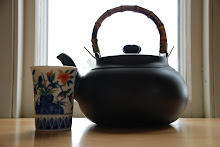
I have a fondness for college towns. Ivory-covered Georgian brick, they breed nostalgia for my college days. It's especially so, at this time of the year, when light so peculiar to late fall evenings permeates all with its magical blush.
Over the weekend, E and I took long strolls through Evanston, and I was in my element. The ambling pace of the town - students wrapped in scarves on bikes weaving around us, graying professor-types with abstracted looks passing by - was a counterpoint to the jostle and blare of nearby Chicago.
We stopped in at Dream about Tea, a Chinese tea house on a street still garnished with fall colors. Inside was a sunny space with neat rows of square wooden tabletops. The proprietor smiled broadly at us behind the counter while I contained my glee as I looked around. Large jars of green Chinese tea lined the countertop although a smattering of blacks, oolongs, pu-erhs, Japanese greens, and whites were present as well. I was giddy as I tried to decide on my first cup of tea.
Caffeine-neediness trumping common sense, I chose a 1st flush Darjeeling over a Chinese green while in a Chinese tea house. The gracious owner brewed my tea in a sturdy glass mug, neatly scooping tea leaves and placing them - without the intermediary of an infuser- directly onto the bottom of the cup. He then poured the hot water over my tea and handed the cup over to me.
E, himself, decided on a Chinese green, the "house" selection. We settled into a shady corner with our cups and waited for our tea to brew. Sunlight dappled on nearby tables, and potted greenery lined the front window, a lushness not echoed by the scrawny, leafless tree outside.
I watched the leaves on the bottom of my cup unfurl into tan filaments and I took my first sip. The Darjeeling was bracing as I had hoped, its dark briskness rousing me from late-morning sleepiness. I continued to drink my tea, the liquor deepening its shade, becoming bitter as I neared the stratum on which the leaves rested - a gentle nudge for me to a have another cup of tea.
Counter to the palate of a proper tea drinker, I chose a Chinese green just after having had a cup of a black tea (custom and perhaps intuition suggest that you should begin a tea tasting with a mild tea like a white or a green. Then you progress to stronger, oxidized ones like oolongs, blacks, pu-erhs). I committed a heterodoxy, indeed.
My host recommended a green, new to me, the Xin Yang Mao Jiang (Fur Tip) from Henan Province. This tea originally belonged to the class of "Famous Teas" of imperial China, a tea befitting emperors, presented to them as tributes.

I watched the needle-shaped leaves unfold their ragged edges in the misty green of the liquor. With my first sip, I tasted the briny notes of steamed leaves. With the second infusion, a sweeter accent emerged, lingering with me, warmed as I was by the meandering sunlight.


















